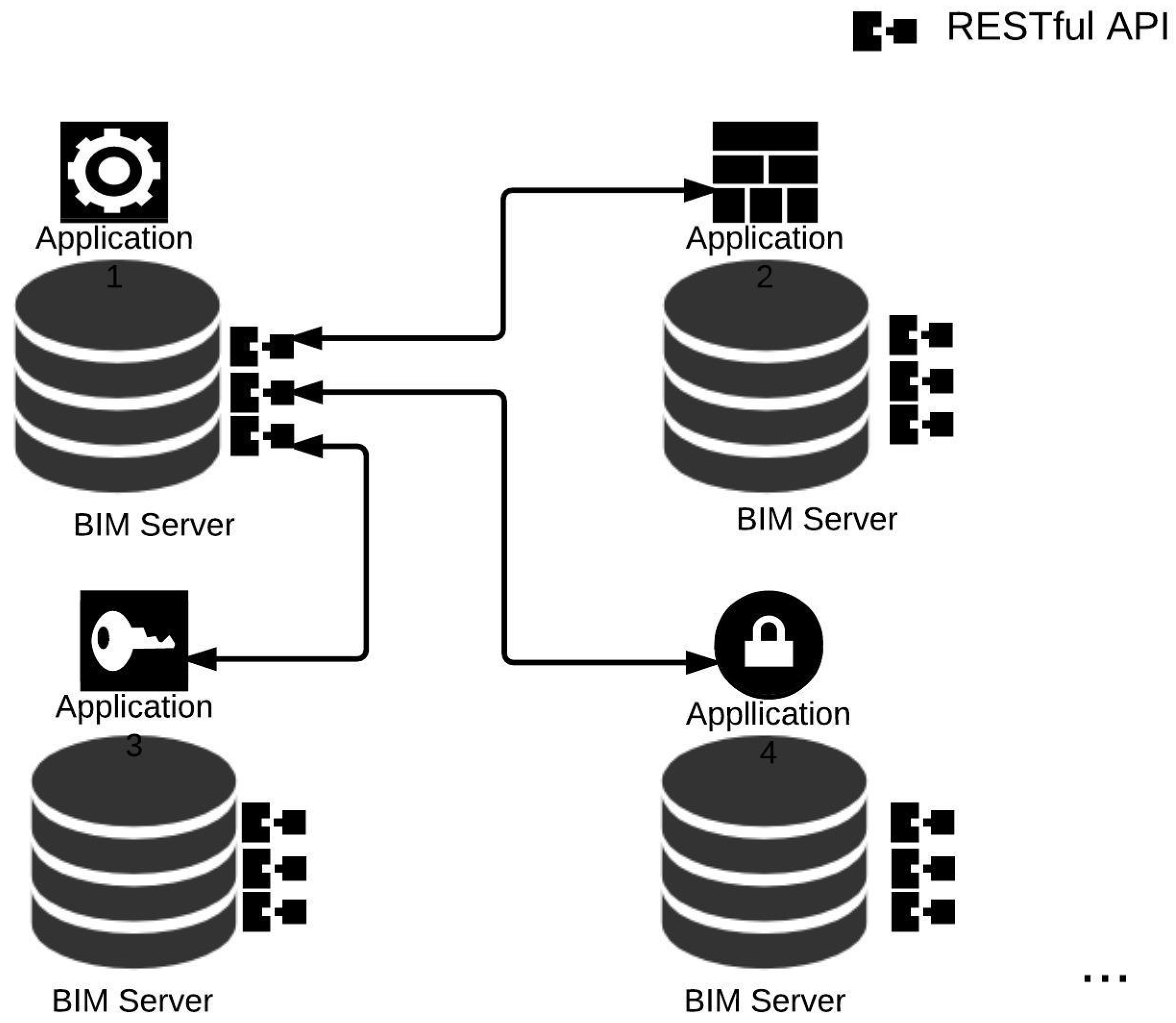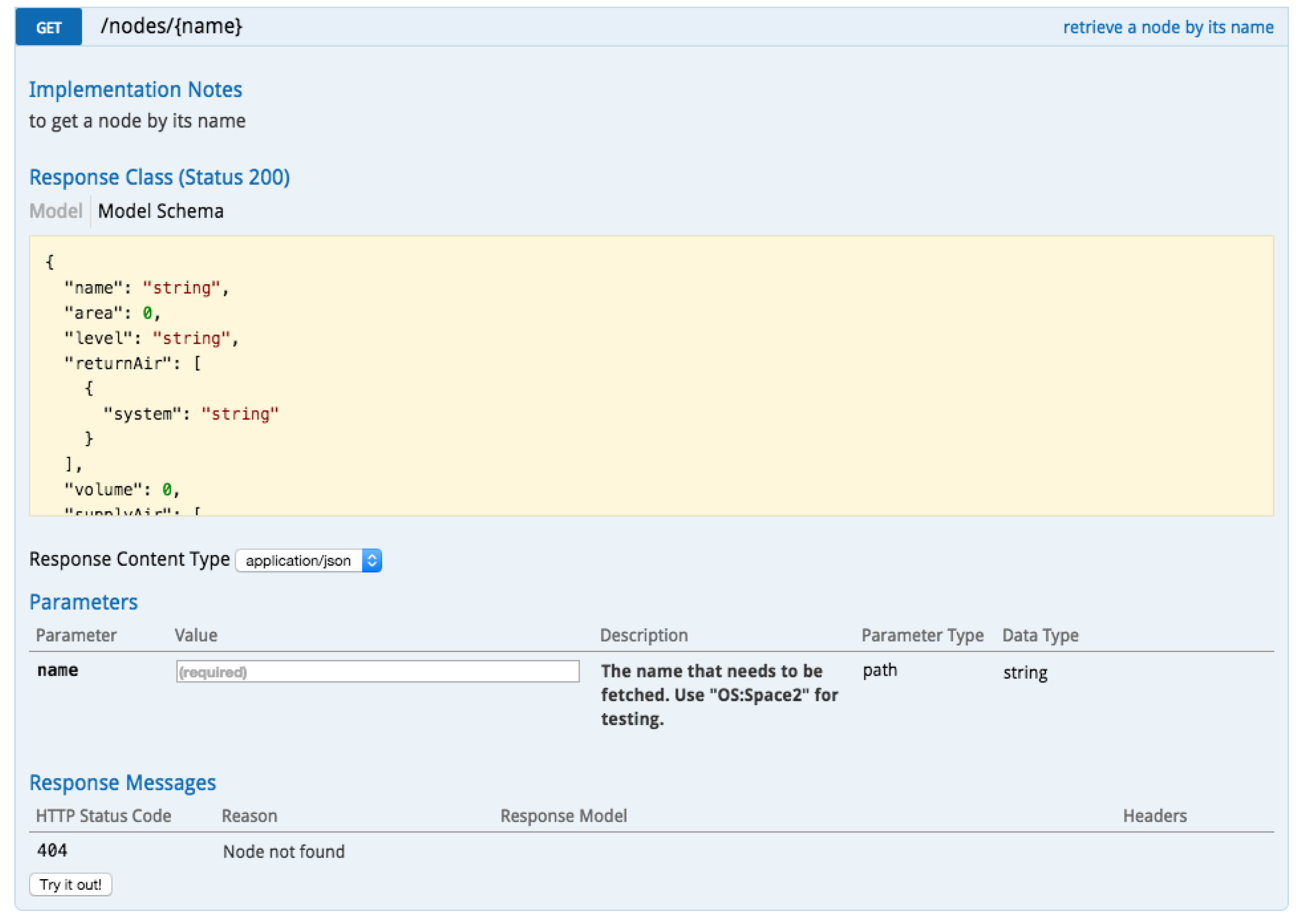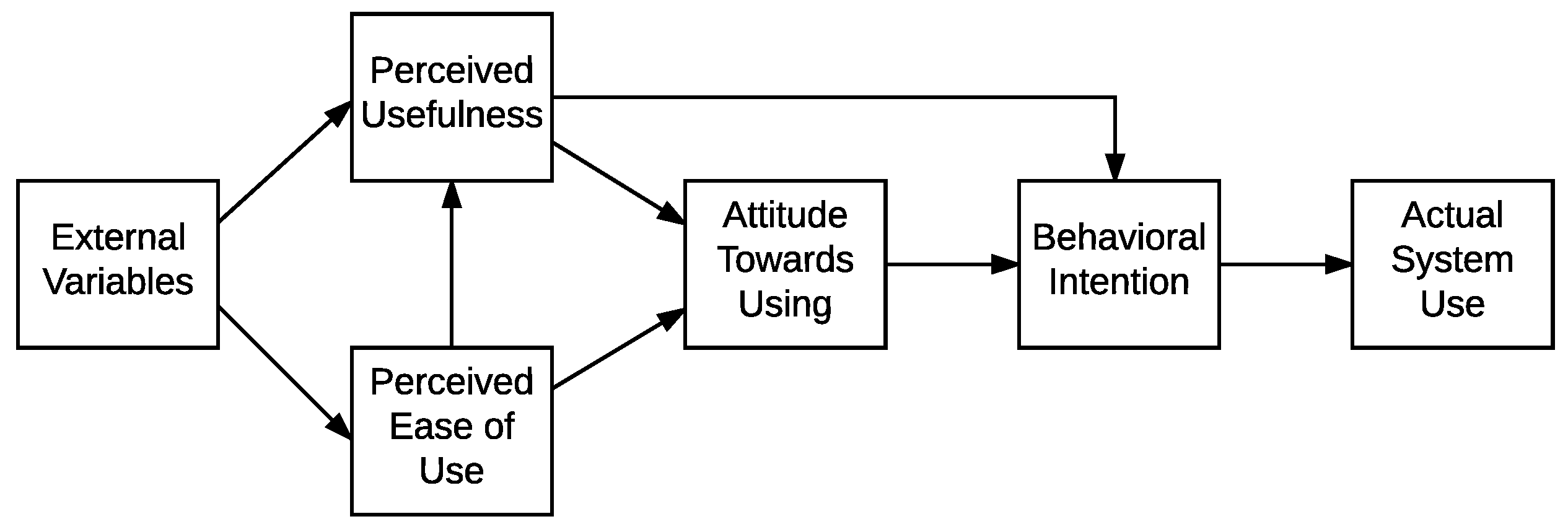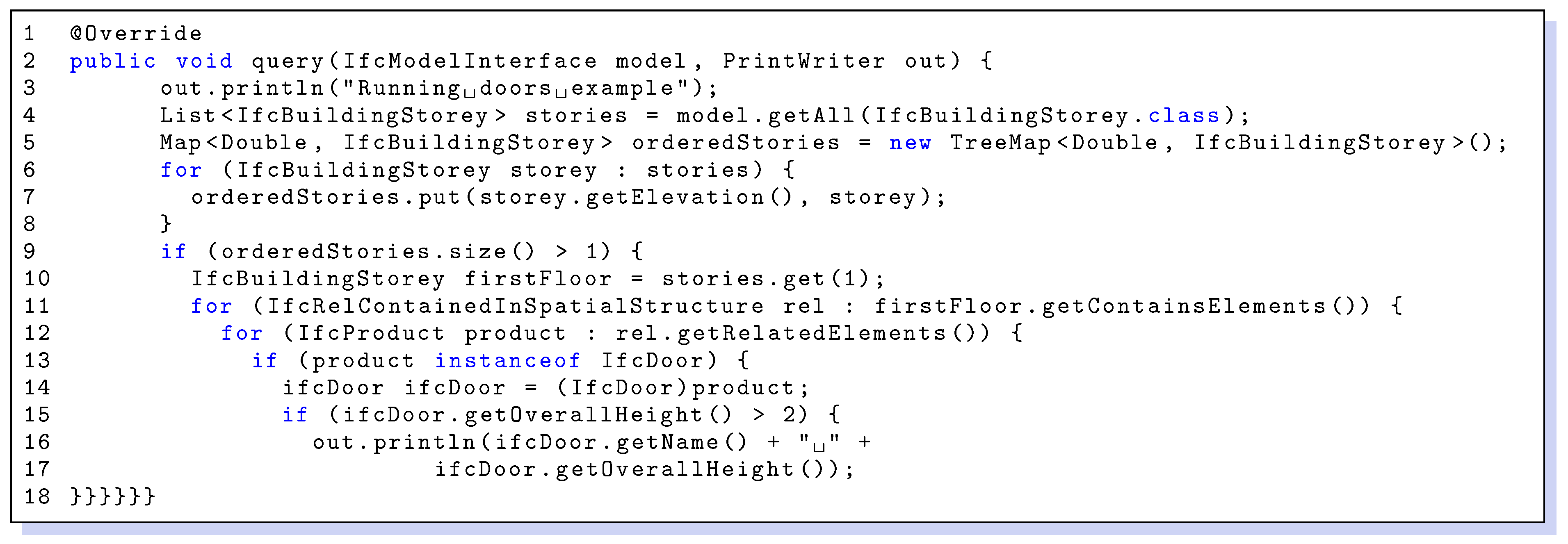An Analysis of BIM Web Service Requirements and Design to Support Energy Efficient Building Lifecycle †
Abstract
:1. Introduction
- We identify the requirements of RESTful BIM web services to support the EEB lifecycle.
- We propose a set of design models of RESTful BIM web services on different abstraction levels.
- We implement a set of RESTful API on a mock BIMserver as a prototype.
- We compare and discuss our design with existing technologies and implementations by conducting a user study under the guidance of TAM.
2. Background and Related Work
2.1. Building Information Modeling
2.2. BIM Applications
2.2.1. BIM to Support Building Life Cycle
2.2.2. BIM to Support Energy Efficient Building Design
3. Requirements
3.1. Information Exchange Requirements
3.2. Distributed Collaboration Requirements
3.3. Internal Data Storage Requirements
3.4. Partial Model Query Requirements
3.4.1. Automated Query Generation from MVD
3.4.2. Query Language
- Compatible with MVDs: Queries should be able to be (semi-)automatically composed based on the existing MVDs,
- Compatible with the RESTful interface,
- Easy for normal users to construct queries, and
- Hidden from the users behind GUI and support transaction queries with ACID (atomicity, consistency, isolation, and durability) [48], and able to reuse routine queries.
4. Design
4.1. Library Component as a Service
4.2. Building Information Model as a Service
4.3. Application as a Service
5. Implementation
5.1. Overall Architecture
5.2. Server Side
5.3. Client Side
6. Evaluation
6.1. Theoretical Framework and Study Measurements
6.1.1. Theoretical Basis
6.1.2. Measurements and Study Design
6.2. Findings
6.2.1. Perceived Ease of Use
“It is really easy to find the operation I want. There are many duplicated API in BIMsie.”(Interviewee 2, analyst and developer)
“I didn’t need to know details of those internal implementation when I was using an API.”(Interviewee 3, analyst and developer)
“It is easier to infer all APIs you need, all the designs stick to one design paradigm. Its readability and learnability is better.”(Interviewee 9, developer)
“RESTful API is not an ad hoc design, there are so many existing open source software, libraries, and packages libraries to help you handle RESTful things. I might even not need to write my own code.”(Interviewee 10, developer)
“All solutions for me need additional learning. However, this design is more general, which means you can find more resources, tutorials, and examples to learn. Even if I need an IT guy to help me, I don’t need to spend time to teach him too much civil engineering knowledge since RESTful APIs hide those details”(Interviewee 5, analyst)
“I feel confused when I was seeing your design, BIMserver interface and those query code. I don’t understand them and don’t know how to use them. I have been doing EEB structure analysis for several years, I haven’t encountered a case that I need web services or RESTful web services. All I rely on is GUI (graphical user interface), like BIMserver’s GUI or Revit GUI. I don’t know if it (the prototype) is easy to others, it is hard to me”(Interviewee 6, analyst)
6.2.2. Perceived Usefulness
I used BIMserver quite a lot, I am very familiar with BIMserver. I have many big project experiences on BIMserver. I definitely know the difficulties when there are so many APIs which are just subtly different and so many data objects. If BIMserver or other BIM platforms integrate your APIs, I prefer to use yours.(Interviewee 2. BIM expert and developer)
I think its usefulness is two-fold. First, you build it based on some general concepts, not IFC. Second, compared with writing advanced query code (in Java), this method allows you to write script in any language and just embed a web request. This feature is useful to me.(Interviewee 8. analyst and developer)
“It is like we achieve the same goal with less effort, so it is useful and I prefer it (RESTful web service).”(Interviewee 3. analyst and developer)
“I believe taking advantage of RESTful web service is a trend. If you see all leading Internet companies like Facebook or Twitter and check their API documents, you will find that all of their web services are based on REST. This design style is also suitable for EEB design.”(Interviewee 1, analyst and developer)
“My requirements and workflow are quite fixed. My daily challenges mainly are analysis logic issues, not related to data exchange. I am familiar with the tools that I am using. I am not sure if I can get benefits from a new tool”(Interviewee 7, analyst)
6.2.3. Attitude Towards Using
“All BIMsie interfaces use HTTP GET method, I felt GET is not supposed to be used to update server side data.”(Interviewee 2, analyst and developer)
“I like how your design organizes everything and hides the internal implementation details. Directly submitting some Java code on a web page may cause some security risks.”(Interviewee 9, developer)
“Error codes are clear, you even don’t need to read error messages. I can easily parse them and have routines to respond”(Interviewee 5, analyst)
The experience of using your prototype is OK. I don’t see many problems there.(Interviewee 7, analyst)
6.2.4. Behavior Intention
“Yes, I think I will use it. And I don’t need to read IFC documents every time.”(Interviewee 8, analyst and developer)
“If BIMserver integrated RESTful web interfaces, then I would definitely use it.”(Interviewee 3, analyst and developer)
“I think it is developer-friendly and user-friendly at the same time. I will use it to request a service, but also use it to launch a service. I know there are many great applications in many labs. Few people know them and many efforts are wasted. They have no incentives to maintain it. If there is a simpler way to deliver your application over web, then more and more researchers can publish their works and they can get more feedback and encouragement. The whole community will benefit from this.”(Interviewee 2, analyst and developer)
“I got your idea, and it is great. However, a tool that was built based on a great idea might not be a great tool. I must see if its document is well-written. I must see if it is mature and stable or it is still fast changing. Considering if I should adopt a tool is different than talking about an idea”(Interviewee 7, analyst)
I think it depends on what kind of projects you are doing. I never need a partial model query and web services.(interviewee 6, analyst)
6.3. Discussion
6.3.1. External Variables
6.3.2. Reflections on the Study
6.3.3. Limitations and Future Work
7. Conclusions
Acknowledgments
Author contributions
Conflicts of Interest
References
- Jiang, Y.; Ming, J.; Wu, D.; Yen, J.; Mitra, P.; Messner, J.I.; Leicht, R. BIM server requirements to support the energy efficient building lifecycle. In Proceedings of the 2012 ASCE International Conference on Computing in Civil Engineering, Clearwater Beach, FL, USA, 17–20 June 2012.
- Watson, A. BIM-a driver for change. In Proceedings of the International Conference on Computing in Civil and Building Engineering, Nottingham University Press, Nottingham, UK, 30 June–2 July 2010.
- Hirsch, A.; Pless, S.; Guglielmetti, R.; Torcellini, P.A.; Okada, D.; Antia, P. The Role of Modeling When Designing for Absolute Energy Use Intensity Requirements in a Design-Build Framework; NREL/CP-5500-49067, National Renewable Energy Laboratory: Golden, CO, USA, 2011. [Google Scholar]
- Bazjanac, V. Acquisition of building geometry in the simulation of energy performance. In Proceedings of the 2001 Building Simulation Conference, Rio de Janeiro, Brazil, 13–15 August 2001.
- Beetz, J.; van Berlo, L.; de Laat, R.; van den Helm, P. BIMserver.org—An open source IFC model server. In Proceedings of the CIP W78 Conference, Cairo, Egypt, 16–18 November 2010.
- Beetz, J.; Berlo, V.L.; Laat, D.R.R.; Bonsma, P. Advances in the development and application of an open source model server for building information. In Proceedings of the CIP W78 Conference, Sophia Antipolis, France, 26–28 October 2011.
- Fielding, R.T. Architectural Styles and the Design of Network-Based Software Architectures. Ph.D. Thesis, University of California, Irvine, CA, USA, 2000. [Google Scholar]
- Legner, C.; Heutschi, R. SOA adoption in practice—Findings from early SOA implementations. In Proceedings of the 2007 European Conference on Information Systems (ECIS 2007), St. Gallen, Switzerland, 7–9 June 2007.
- Michelson, B.M. Event-driven architecture overview. Patricia Seybold Group 2006, 2. [Google Scholar] [CrossRef]
- Exforsys. SOA Disadvantage, 2007. Available online: http://www.exforsys.com/tutorials/soa/soa-disadvantages.html (accessed on 1 August 2015).
- Associates, J.J.H. Welcome to DOE-2.com. Available online: http://www.doe2.com/ (accessed on 28 April 2016).
- O’Donnell, J. SimModel: A domain data model for whole building energy simulation. In Proceedings of the SimBuild 2011, Sydney, Australia, 14–16 November 2011.
- Campbell, D.A. Building information modeling: The Web3D application for AEC. In Proceedings of the Twelfth International Conference on 3D Web Technology, ACM, Umbria, Italy, 15–18 April 2007.
- BuildingSMARTalliance. United States National Building Information Modeling Standard, 2007. Available online: http://www.wbdg.org/pdfs/NBIMSv1_p1.pdf (accessed on 3 August 2015).
- Eastman, C.; Eastman, C.M.; Teicholz, P.; Sacks, R. BIM Handbook: A Guide to Building Information Modeling for Owners, Managers, Designers, Engineers and Contractors; John Wiley & Sons: Hoboken, NJ, USA, 2011. [Google Scholar]
- Liu, F.; Jallow, A.; Anumba, C.; Wu, D. Building knowledge modeling: Integrating knowledge in BIM. In Proceedings of the 30th International Conference on Applications of IT in the AEC Industry, Beijing, China, 9–12 October 2013.
- Smith, D.K.; Tardif, M. Building Information Modeling: A Strategic Implementation Guide for Architects, Engineers, Constructors, and Real Estate Asset Managers; John Wiley & Sons: Hoboken, NJ, USA, 2009. [Google Scholar]
- Azhar, S. Building information modeling (BIM): Trends, benefits, risks, and challenges for the AEC industry. Leadersh. Manag. Eng. 2011, 11, 241–252. [Google Scholar] [CrossRef]
- Howell, I.; Batcheler, B. Building information modeling two years later—Huge potential, some success and several limitations. Laiserin Lett. 2005, 22, 4. [Google Scholar]
- Goedert, J.D.; Meadati, P. Integrating construction process documentation into building information modeling. J. Constr. Eng. Manag. 2008, 134, 509–516. [Google Scholar] [CrossRef]
- Bynum, P.; Issa, R.R.; Olbina, S. Building information modeling in support of sustainable design and construction. J. Constr. Eng. Manag. 2012, 139, 24–34. [Google Scholar] [CrossRef]
- Zhang, S.; Teizer, J.; Lee, J.K.; Eastman, C.M.; Venugopal, M. Building information modeling (BIM) and safety: Automatic safety checking of construction models and schedules. Autom. Constr. 2013, 29, 183–195. [Google Scholar] [CrossRef]
- Kim, C.; Son, H.; Kim, C. Automated construction progress measurement using a 4D building information model and 3D data. Autom. Constr. 2013, 31, 75–82. [Google Scholar] [CrossRef]
- Messner, J.; Anumba, C.; Dubler, C.; Goodman, S.; Kasprzak, C.; Kreider, R.; Leicht, R.; Saluja, C.; Zikic, N. BIM project execution planning guide and templates: version 2.0. Available online: http://bim.psu.edu/Resources/Project/BIM_PxP-V2.1/BIM_PxP_Guide_&_Templates_V2.1.zip (accessed on 15 July 2015).
- Maile, T.; Fischer, M.; Bazjanac, V. Building energy performance simulation tools—A life-cycle and interoperable perspective. Center Integr. Facil. Eng. (CIFE) Working Pap. 2007, 107, 1–49. [Google Scholar]
- Bazjanac, V. Impact of the US national building information model standard (NBIMS) on building energy performance simulation. In Proceedings of the Building Simulation 2007 Conference, Beijing, China, 3–6 September 2007.
- Young, N.; Jones, S.; Bernstein, H.M.; Gudgel, J. The Business Value of Bim—Getting Building Information Modeling to the Bottom Line; McGraw-Hill Construction: Bedford, MA, USA, 2009. [Google Scholar]
- Moon, H.J.; Choi, M.S.; Kim, S.K.; Ryu, S.H. Case studies for the evaluation of interoperability between a BIM based architectural model and building performance analysis programs. In Proceedings of 12th Conference of International Building Performance Simulation Association, Sydney, Australia, 14–16 November 2011.
- Jiang, Y.; Yu, N.; Ming, J.; Lee, S.; DeGraw, J.; Yen, J.; Messner, J.I.; Wu, D. Automatic building information model query generation. J. Inf. Technol. Constr. (ITCon) 2015, 20, 518–535. [Google Scholar]
- Yu, N.; Jiang, Y.; Luo, L.; Lee, S.; Jallow, A.; Wu, D.; Messner, J.I.; Leicht, R.M.; Yen, J. Integrating BIMserver and OpenStudio for energy efficient building. In Proceedings of the 2013 ASCE International Conference on Computing in Civil Engineering, Los Angeles, CA, USA, 23–25 June 2013.
- Liu, F.; Jallow, A.K.; Anumba, C.J.; Wu, D. A framework for integrating change management with building information modeling. In Proceedings of the 15th International Conference on Computing in Civil and Building Engineering (ICCCBE 2014), ASCE, Orlando, FL, USA, June 23–25 2014.
- Dubler, C.R.; Messner, J.; Anumba, C.J. Using lean theory to identify waste associated with information exchanges on a building project. In Proceedings of the Construction Research Congress/ASCE Conference, Banff, AL, Canada, 8–10 May 2010.
- Rogers, S. BIM Implementation Strategies: Two Models or One? Available online: http://old.agc.org/galleries/conmark/Rogers2008 (accessed on 16 July 2015).
- Yan, H.; Damian, P. Benefits and barriers of building information modelling. In Proceedings of the 12th International Conference on Computing in Civil and Building Engineering, Beijing, China, 16–18 October 2008.
- Curbera, F.; Duftler, M.; Khalaf, R.; Nagy, W.; Mukhi, N.; Weerawarana, S. Unraveling the Web services web: An introduction to SOAP, WSDL, and UDDI. IEEE Internet Comput. 2002, 6, 86–93. [Google Scholar] [CrossRef]
- Hardt, D. The OAuth 2.0 Authorization Framework. Available online: http://tools.ietf.org/html/rfc6749.html (accessed on 17 July 2015).
- Is OAuth Stateless? Can it Work for REST? Available online: https://looselyconnected.wordpress.com/2010/11/12/is-oauth-stateless-can-it-work-for-rest/ (accessed on 18 July 2010).
- Liu, D.T.; Xu, X.W. A review of web-based product data management systems. Comput. Ind. 2001, 44, 251–262. [Google Scholar]
- Bilgic, T.; Rock, D. Product data management systems: State of the art and the future. In Proceedings of the 1997 ASME Design Engineering Technical Conferences and Computers in Engineering Conference, paper No. DETC97/EIM-3720. Sacramento, CA, USA, 14–17 September 1997.
- Murugesan, S. Understanding Web 2.0. IT Prof. 2007, 9, 34–41. [Google Scholar] [CrossRef]
- Van Berlo, L. BIMServer.org Release 1.3.0 Final. Available online: http://bimserver.org/2014/04/28/release-1-3-0-final/ (accessed on 20 July 2015).
- Froese, T.; Fischer, M.; Grobler, F.; Ritzenthaler, J.; Yu, K.; Sutherland, S.; Staub, S.; Akinci, B.; Akbas, R.; Koo, B.; et al. Industry foundation classes for project management-a trial implementation. Electr. J. Inf. Technol. Constr. 1999, 4, 17–36. [Google Scholar]
- Adachi, Y. Overview of partial model query language. In Proceedings of the International Society for Productivity Enhancement Concurrent Engineering Conference (ISPE CE), Madeira, Portugal, 26–30 July 2003.
- Camposano, R.; Saunders, L.F.; Tabet, R.M. High-level synthesis from VHDL. IEEE Des. Test Comput. 1991, 8, 43–49. [Google Scholar] [CrossRef]
- Weise, M.; Katranuschkov, P.; Scherer, R.J. Generalised model subset definition schema. CIB Rep. 2003, 284, 440. [Google Scholar]
- Mazairac, W.; Beetz, J. BIMQL—An open query language for building information models. Adv. Eng. Inform. 2013, 27, 444–456. [Google Scholar] [CrossRef]
- Daum, S.; Borrmann, A.; Langenhan, C.; Petzold, F. Automated generation of building fingerprints using a spatio-semantic query language for building information models. In eWork and eBusiness in Architecture, Engineering and Construction: ECPPM 2014; CRC Press: Vienna, Austria, 2014. [Google Scholar]
- Gray, J.; Reuter, A. Transaction Processing; Morgan Kaufíann Publishers: San Francisco, CA, USA, 1993. [Google Scholar]
- Allamaraju, S. Restful Web Services Cookbook: Solutions for Improving Scalability and Simplicity; O’Reilly Media, Inc.: Sebastopol, MA, USA, 2010. [Google Scholar]
- DeGraw, J.W.; Macumber, D.; Bahnfleth, W.P. Generation of multizone airflow models from building energy models. ASHRAE Trans. 2014, 120, 1–8. [Google Scholar]
- Emmerich, S.J.; Persily, A.K. US commercial building airtightness requirements and measurements. In Proceedings of the AIVC Conference, Brussels, Belgium, 12–13 October 2011.
- yaml.org. YAML 1.2. Available online: http://www.yaml.org/ (accessed on 1 March 2016).
- cURL project. Available online: https://curl.haxx.se/ (accessed on 1 March 2016).
- SmartBear. Available online: http://swagger.io/ (accessed on 1 March 2016).
- Davis, F.D., Jr. A Technology Acceptance Model for Empirically Testing New End-User Information Systems: Theory and Results. Ph.D. Thesis, Massachusetts Institute of Technology, Cambridge, MA, USA, 1986. [Google Scholar]
- Adams, D.A.; Nelson, R.R.; Todd, P.A. Perceived usefulness, ease of use, and usage of information technology: A replication. MIS Q. 1992, 16, 227–247. [Google Scholar] [CrossRef]
- Chau, P.Y. An empirical assessment of a modified technology acceptance model. J. Manag. Inf. Syst. 1996, 13, 185–204. [Google Scholar] [CrossRef]
- Chau, P.Y. An empirical investigation on factors affecting the acceptance of CASE by systems developers. Inf. Manag. 1996, 30, 269–280. [Google Scholar] [CrossRef]
- Davis, F.D. Perceived usefulness, perceived ease of use, and user acceptance of information technology. MIS Q. 1989, 13, 319–340. [Google Scholar] [CrossRef]
- Davis, F.D.; Bagozzi, R.P.; Warshaw, P.R. User acceptance of computer technology: A comparison of two theoretical models. Manag. Sci. 1989, 35, 982–1003. [Google Scholar] [CrossRef]
- Hu, P.J.; Chau, P.Y.; Sheng, O.R.L.; Tam, K.Y. Examining the technology acceptance model using physician acceptance of telemedicine technology. J. Manag. Inf. Syst. 1999, 16, 91–112. [Google Scholar] [CrossRef]
- Ajzen, I.; Fishbein, M. Attitude-behavior relations: A theoretical analysis and review of empirical research. Psychol. Bull. 1977, 84, 888. [Google Scholar] [CrossRef]
- Berlotti. BIMSie-API. Available online: https://github.com/BuildingSMART/BIMSie-API (accessed on 3 March 2015).
- Berlotti. New Year’s Resolutions. Available online: http://bimserver.org/2015/12/23/new-years-resolutions/ (accessed on 3 March 2015).















| EndPoint | Method | Resource Description |
|---|---|---|
| /buildings/{name} | GET | The whole building airflow network model |
| /nodes | GET, PUT, POST | Enclosed areas of the building are the nodes in the model. by hitting endpoints nodes, users will retrieve all the available nodes in the model. |
| /nodes/{name} | GET, PUT, POST | This endpoint refers to the nodes specified by their names. |
| /paths/{name} | GET, PUT, POST | A path is a potential avenue of airflow. Each wall or component may have leakage, then there is a path defined upon it. This end point refers to the paths specified by their names. refers to the paths specified. |
| /thermalZones | GET, PUT, POST | Thermal zones are not airflow zones. A thermal zone contains all the space which have similar thermal loads for an HVAC system. This endpoint refers to all the thermal zones in the model. |
| /thermalZones/{id} | GET, PUT, POST | This endpoint refers to the thermal zones specified by their names. |
| /users/{username} | GET, PUT, POST, DELETE | This endpoint makes users’ information accessible. |
| addUser | setAllowUsersToCreateTopLevelProjects |
| addUserToExtendedDataSchema | undeleteUser |
| addUserToProject | removeUserFromProject |
| changeUserType | userHasCheckinRights |
| loginUserToken | userHasCheckinRights |
| getAllAuthorizedUsersOfProject | newUser |
| getAllCheckoutsByUser | userHasRights |
| getAllNonAuthorizedProjectsOfUser | deleteUser |
| getAllRevisionsByUser | getLoggedInUser |
| getUserByUoid | isAllowUsersToCreateTopLevelProjects |
| getUserByUserName | isHideUserListForNonAdmin |
| getUserRelatedLogs | setHideUserListForNonAdmin |
| getUserSettings | getUsersProjects |
| getAllUsers | getAllNonAuthorizedUsersOfProject |
| registerNewUserHandler | unregisterNewUserHandler |
| User Number | Tags | PEOU | PU | ATU | BIU |
|---|---|---|---|---|---|
| 1 | Analyst & Programmer | ✓ | ✓ | ✓ | ✓ |
| 2 | Analyst & Programmer | ✓ | ✓ | ✓ | ✓ |
| 3 | Analyst & Programmer | ✓ | ✓ | ✓ | ✓ |
| 8 | Analyst & Programmer | ✓ | ✓ | ✓ | – |
| 4 | Programmer | ✓ | ✓ | ✓ | ✓ |
| 9 | Programmer | ✓ | ✓ | ✓ | ✓ |
| 10 | Programmer | ✓ | ✓ | ✓ | ✓ |
| 5 | Analyst | ✓ | ✓ | ✓ | ✓ |
| 6 | Analyst | ✗ | ✗ | – | ✗ |
| 7 | Analyst | – | ✗ | – | ✗ |
© 2016 by the authors; licensee MDPI, Basel, Switzerland. This article is an open access article distributed under the terms and conditions of the Creative Commons Attribution (CC-BY) license (http://creativecommons.org/licenses/by/4.0/).
Share and Cite
Jiang, Y.; Liu, X.; Liu, F.; Wu, D.; Anumba, C.J. An Analysis of BIM Web Service Requirements and Design to Support Energy Efficient Building Lifecycle. Buildings 2016, 6, 20. https://doi.org/10.3390/buildings6020020
Jiang Y, Liu X, Liu F, Wu D, Anumba CJ. An Analysis of BIM Web Service Requirements and Design to Support Energy Efficient Building Lifecycle. Buildings. 2016; 6(2):20. https://doi.org/10.3390/buildings6020020
Chicago/Turabian StyleJiang, Yufei, Xiao Liu, Fangxiao Liu, Dinghao Wu, and Chimay J. Anumba. 2016. "An Analysis of BIM Web Service Requirements and Design to Support Energy Efficient Building Lifecycle" Buildings 6, no. 2: 20. https://doi.org/10.3390/buildings6020020
APA StyleJiang, Y., Liu, X., Liu, F., Wu, D., & Anumba, C. J. (2016). An Analysis of BIM Web Service Requirements and Design to Support Energy Efficient Building Lifecycle. Buildings, 6(2), 20. https://doi.org/10.3390/buildings6020020







